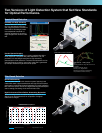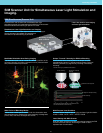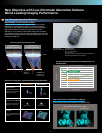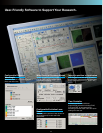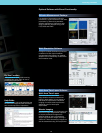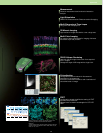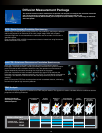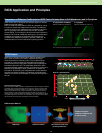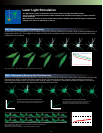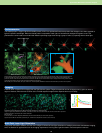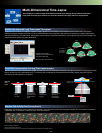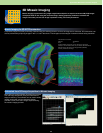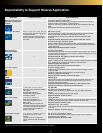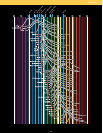
This optional software module enables data acquisition and analysis to investigate the molecular interaction
and concentrations by calculating the diffusion coefficients of molecules within the cell.
Diverse analysis methods (RICS/ccRICS, point FCS/point FCCS and FRAP) cover a wide range of molecular
sizes and speeds.
Diffusion Measurement Package
105
105
125
Pixels
Pixels
125
130
130
0
0.5
1
1.5
p
oint FCS
RICS
FRAP
> 1
00
Capable range
of measurement
~ 1
00
1 ~ 1
00
<
0
.
1
<
0
.
01
<<
0
.
001
Small molecules
in
so
l
u
ti
o
n
Proteins
in
so
l
u
ti
o
n
Diffusion of
p
roteins
in
ce
ll
Molecular com
p
le
x
formation
,
a
gg
re
g
ation
Protein
traffickin
g
Lateral diffusion
in
ce
ll m
e
m
b
r
a
n
e
RICS—Raster Imaging Correlation Spectroscopy
Raster image correlation spectroscopy (RICS) is a new method for analyzing the diffusion
and binding dynamics of molecules in an entire, single image. RICS uses a spatial
correlation algorithm to calculate diffusion coefficients and the number of molecules in
specified regions.
Cross correlation RICS (ccRICS) characterizes molecular interactions using fluorescent-
labeled molecules in two colors.
FRAP Analysis
The Axelrod analytical algorithm is installed as a FRAP analysis method. The algorithm is used to calculate diffusion coefficients and the
proportions of diffusing molecules.
point FCS—Point scan Fluorescence Correlation Spectroscopy
point scan fluorescence correlation spectroscopy (point FCS) analyzes intensity
fluctuations caused by diffusion or binding/unbinding interactions of a protein complex.
point FCS uses an auto correlation function to carry out operations on fluorescence
signals obtained by continuous scanning of a single pixel on the screen.
point scan fluorescence cross-correlation spectroscopy (point FCCS) analyzes the
fluctuation of fluorescent-labeled molecules in two colors. The coincidence of fluctuations
occurring in two detection channels shows that the two proteins are part of the same
complex.
point FCS and point FCCS can now be performed with a standard detector, eliminating
the need for a special high-sensitivity detector.
Analytical methods
according to molecule
diffusion speeds
15



